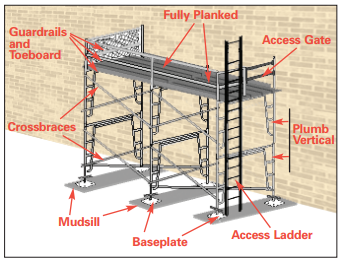Affordable and Professional Scaffolding Cobham Services Available Now
Affordable and Professional Scaffolding Cobham Services Available Now
Blog Article
The Advantages of Scaffolding for Safety And Security and Performance in Building Projects
Scaffolding is an important component in the world of building, considerably adding to both security and operational efficiency. The influence of scaffolding prolongs beyond standard security measures; its critical application can transform job timelines and outcomes (Scaffolding).
Boosted Employee Safety

Boosted worker security is an extremely important issue in the building and construction industry, where the dangers linked with drops and accidents can have dire effects. Reliable scaffolding systems play an important duty in minimizing these risks by supplying secure systems for workers at elevated heights. By making sure that scaffolding is effectively put up and maintained, building business can substantially lower the likelihood of falls, which are among the leading root causes of work environment injuries and deaths.
Additionally, scaffolding boosts safety and security via its layout features. Guardrails, toe boards, and non-slip surfaces add to a secure workplace, minimizing the risk of accidents. Additionally, scaffolding allows workers to access hard-to-reach locations without the demand for makeshift remedies, which can endanger safety and security criteria.
Educating employees on the appropriate use of scaffolding is similarly essential. Guaranteeing that workers are well-informed about load abilities, setting up treatments, and security protocols further boosts the performance of scaffolding in protecting against crashes. To conclude, including robust scaffolding systems within building projects not only improves worker safety and security yet likewise promotes a society of security that benefits the whole workforce while enhancing total efficiency.
Improved Access and Mobility

Moreover, scaffolding permits the convenient transportation of products and devices, decreasing downtime related to relocating equipment. Employees can successfully access numerous locations of a task, which is specifically crucial in complicated builds where upright and horizontal motion is frequent - Scaffolding. This ease of access not only streamlines procedures yet additionally makes it possible for groups to respond quickly to changing task needs
Furthermore, scaffolding can be tailored to accommodate specific website problems, enhancing mobility in tight or uneven spaces. This flexibility makes certain that building activities can proceed efficiently, regardless of the challenges presented by the setting. By promoting enhanced access and mobility, scaffolding plays a crucial duty in supporting construction staffs and enhancing the overall performance of building tasks.
Boosted Project Performance
In building and construction, project performance is substantially influenced by the reliable use of scaffolding systems. By giving a steady and secure system for workers, scaffolding decreases downtime and speeds up the rate of building tasks. With improved accessibility to elevated job areas, teams can finish jobs quicker, lowering the total project timeline.
The modular nature of contemporary scaffolding permits fast setting up and disassembly, allowing swift shifts in between different phases of a task. This adaptability not only boosts workflow however additionally adds to better sychronisation amongst various trades, as several groups can function at the same time on various areas of a framework.
Additionally, scaffolding makes sure that employees are positioned correctly to do their jobs without unneeded pressure or risk of injury, thus minimizing the chance of crashes that can lead to costly delays. Improved precaution installed in scaffolding systems, such as guardrails and toe boards, more assistance efficient operations by maintaining worker concentrate on the task at hand instead of safety issues.

Adaptability for Various Tasks
Scaffolding systems attract attention for their adaptability throughout a vast array of building and construction tasks, efficient in meeting details site requirements and tasks. Their modular layout enables quick modifications to suit numerous building types, from property to business frameworks, ensuring that workers have risk-free accessibility at various elevations and angles.
These systems can be tailored for diverse applications, such as façade job, indoor improvements, or heavy-duty industrial projects. For instance, lightweight light weight aluminum scaffolds are excellent for indoor job, while durable steel frameworks provide the required support for massive building. The flexibility of scaffolding prolongs to its capability to be configured for both permanent and temporary structures, permitting contractors to successfully intend and perform their jobs.
Furthermore, scaffolding can be employed in challenging environments, consisting of metropolitan settings where space is limited or on irregular surface where standard gain access to services are impractical. This adaptability decreases the requirement for multiple access remedies, minimizing expenses and project timelines. By suiting a selection of problems and tasks, scaffolding enhances the total effectiveness and effectiveness of building and construction initiatives, showing to be a crucial asset in the building industry.
Conformity With Security Standards
Just how can building projects make certain the security of employees while preserving efficiency? Conformity with safety requirements is paramount in attaining this balance. Governing frameworks, such as OSHA in the USA, provide guidelines that control using scaffolding, making certain that it satisfies rigorous safety standards. By adhering scaffolding questioning to these requirements, building and construction companies can lessen the risk of mishaps, which not just safeguards employees yet also improves total project effectiveness.
Proper scaffolding design and installation play a critical role in conformity. Educating employees on risk-free scaffold use and the significance of compliance with safety criteria better enhances a society of security on-site.
Furthermore, documentation and record-keeping related to scaffolding und fading safety and security examinations and employee training are important. These practices not just show compliance but additionally supply responsibility and transparency. Inevitably, by focusing on adherence to security standards, building and construction jobs can foster a more secure workplace, thereby boosting efficiency and efficiency without endangering worker safety and security.
Verdict
In final thought, scaffolding acts as an essential element in building tasks, significantly boosting security and efficiency. Its style features, consisting of guardrails and non-slip surfaces, add to a much safer working environment while promoting improved accessibility and movement for employees. The modular nature of scaffolding promotes fast setting up, therefore raising overall task efficiency. Moreover, adherence to safety requirements emphasizes the significance of scaffolding in attaining successful job end results, making it important in the building and construction industry.
Scaffolding is a necessary Extra resources component in the realm of building, significantly contributing to both security and functional effectiveness. The impact of scaffolding extends past standard safety and security measures; its calculated execution can change task timelines and end results. In verdict, incorporating robust scaffolding systems within building projects not only improves worker safety but also advertises a society of security that benefits the entire labor force while boosting total efficiency.
In final thought, scaffolding serves as a vital part in structure jobs, considerably enhancing safety and security and performance. Adherence to security standards underscores the relevance of scaffolding in accomplishing successful task end results, making it vital in the building industry.
Report this page